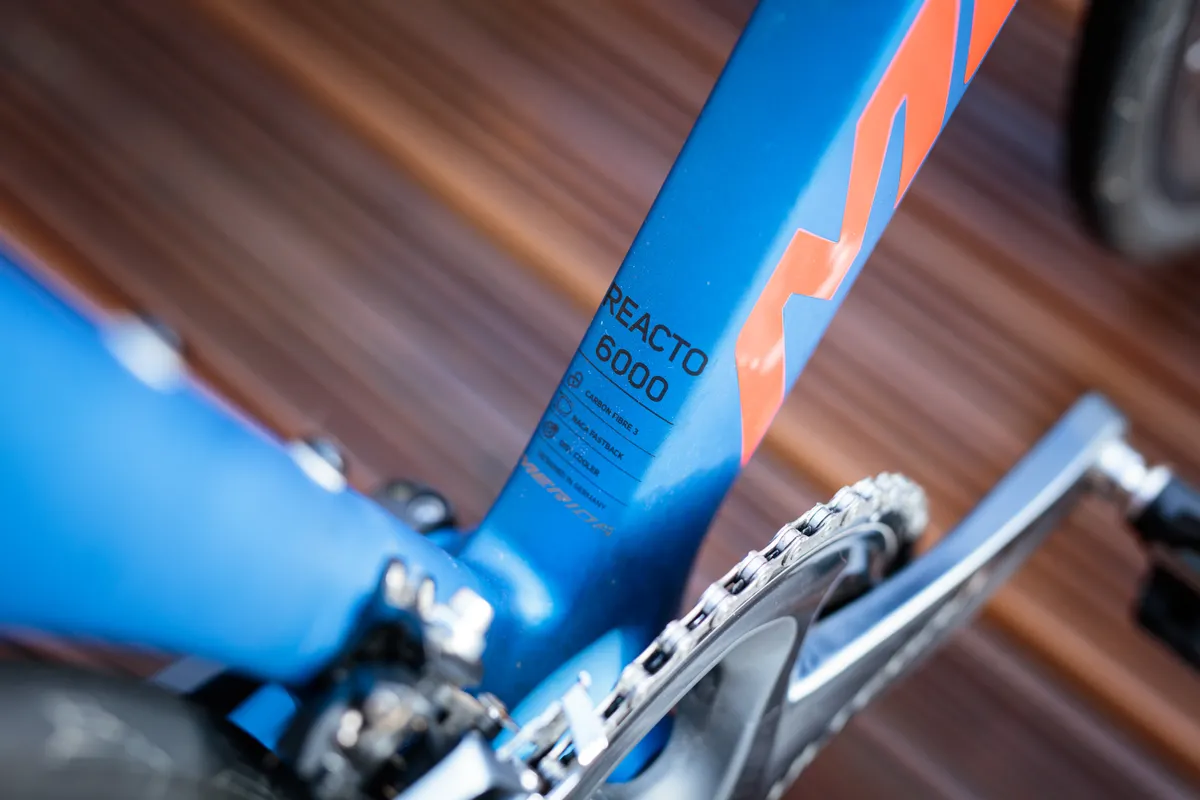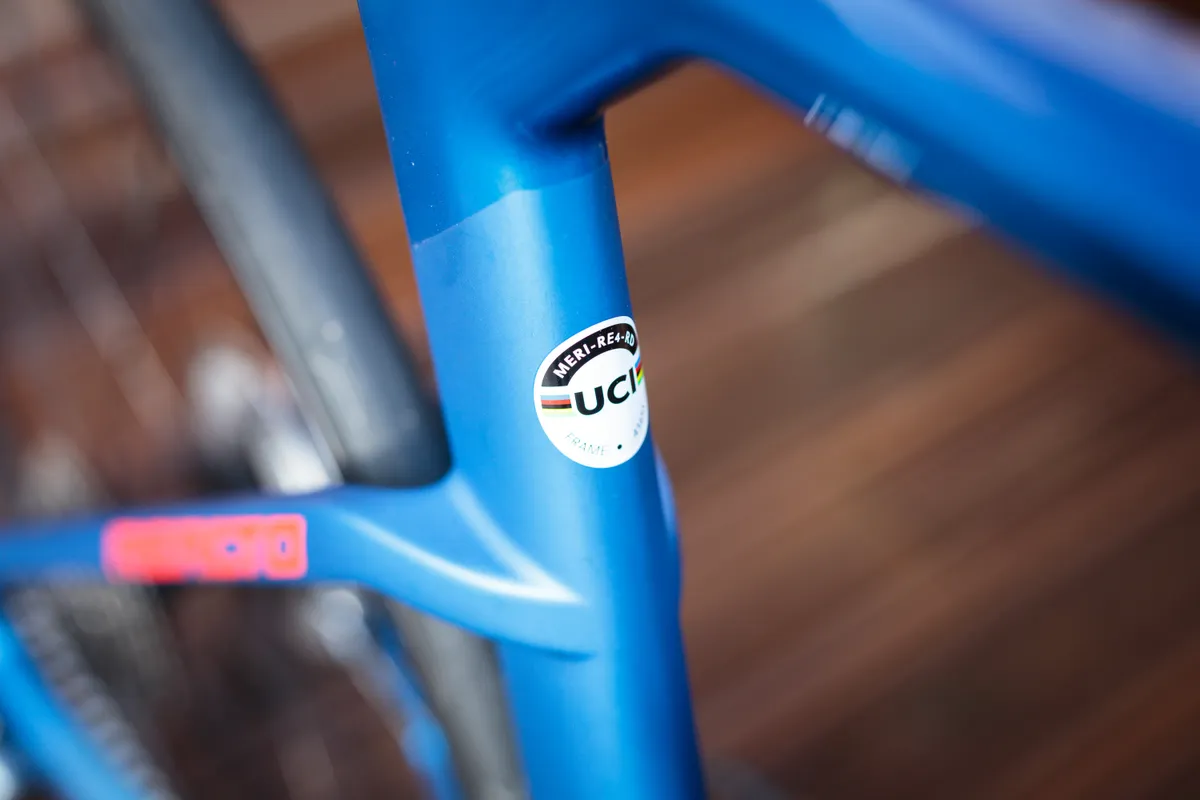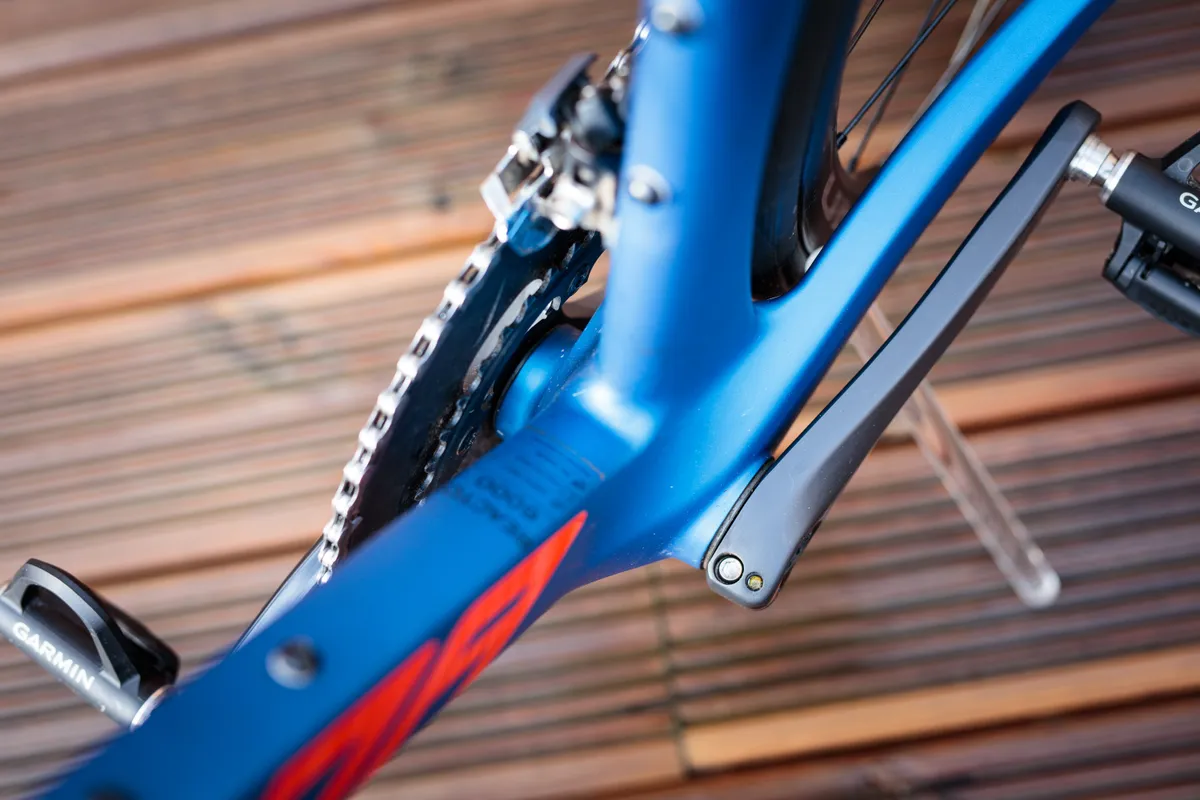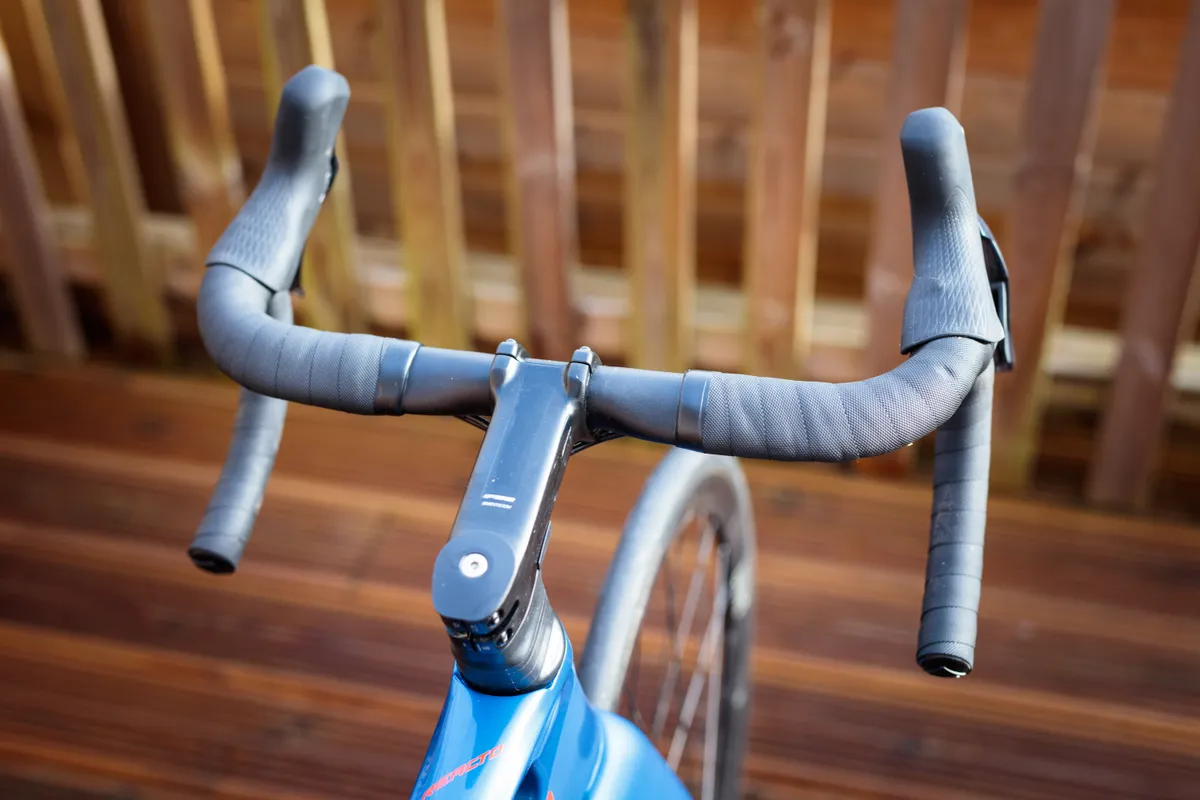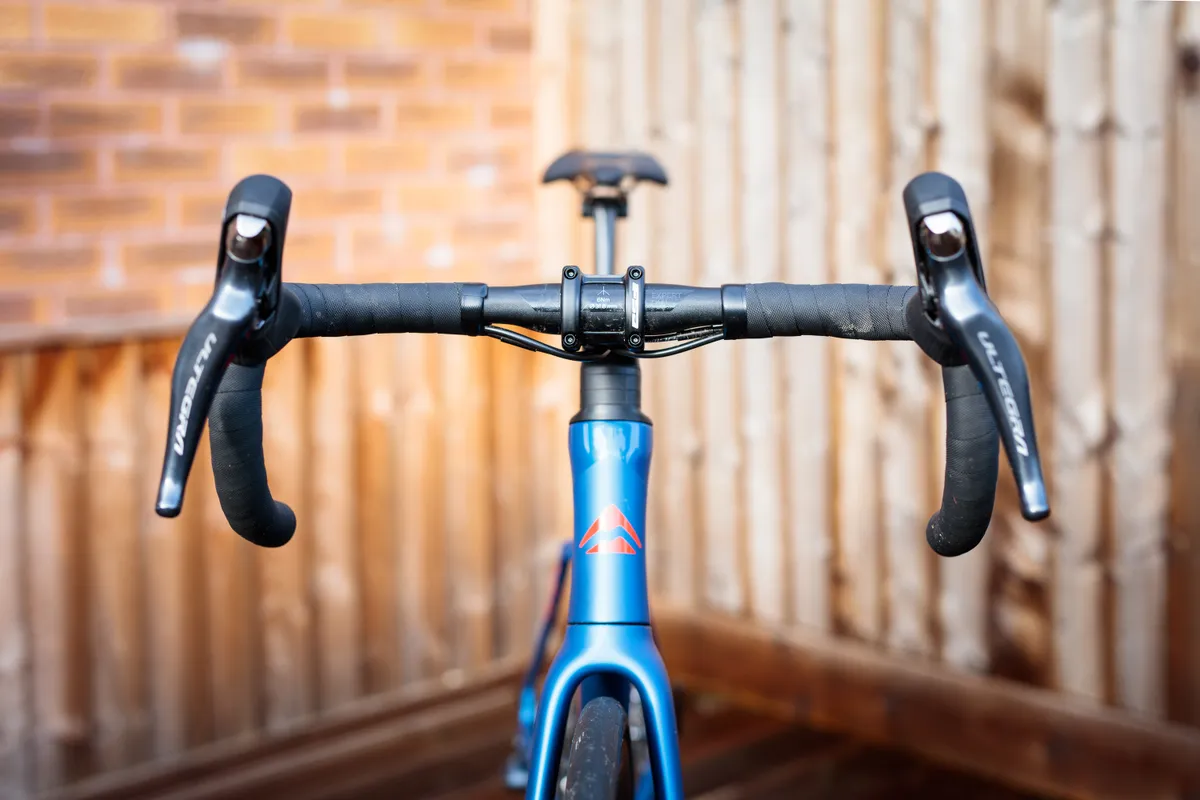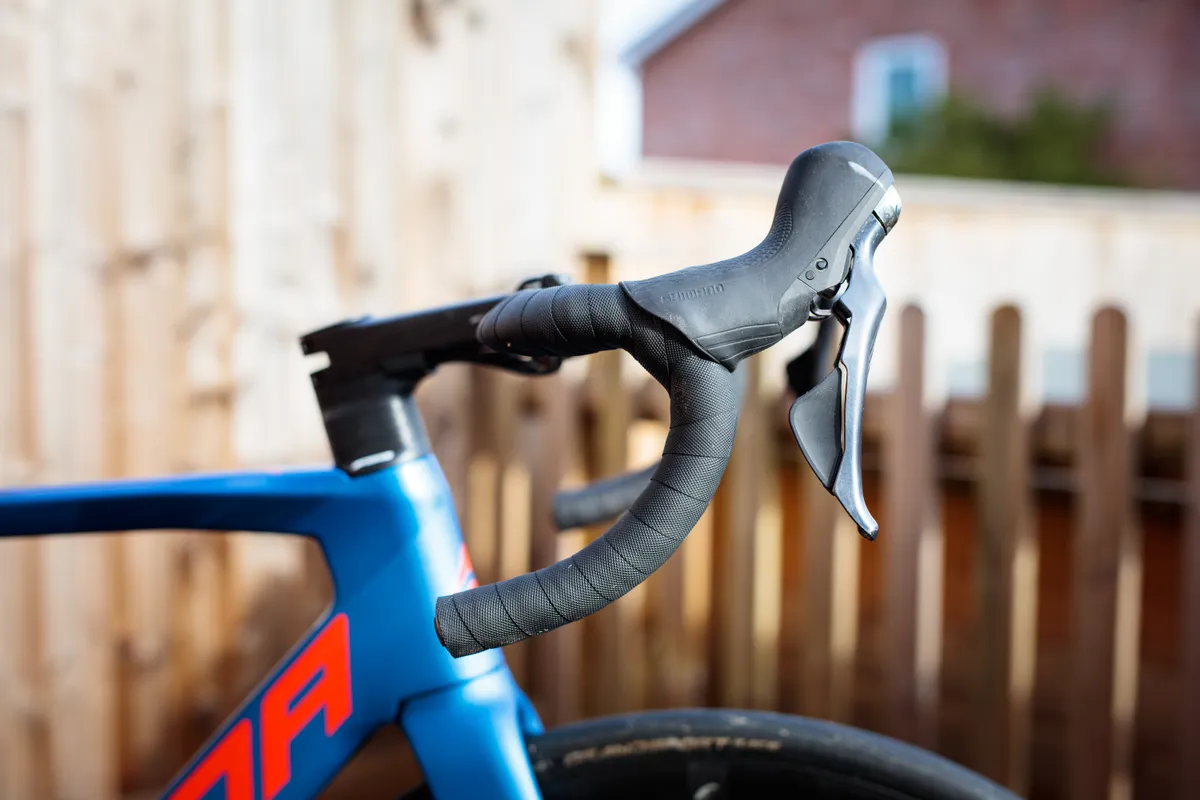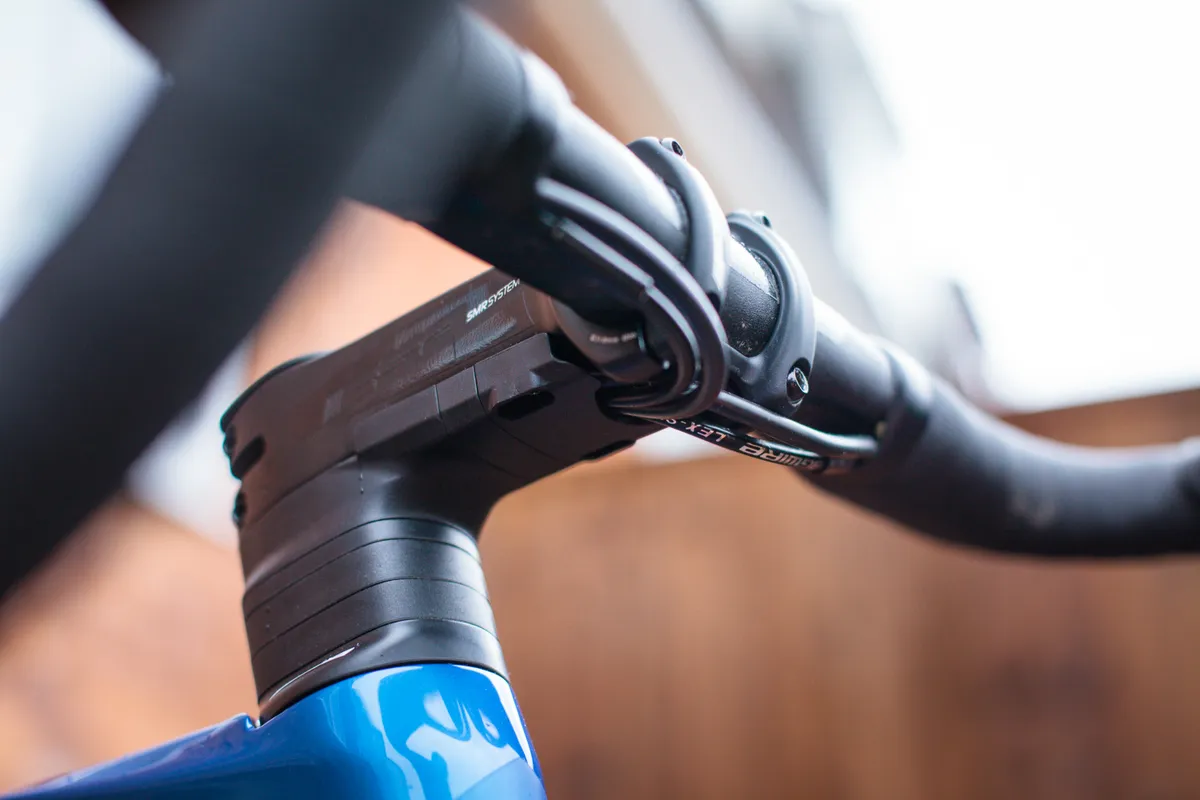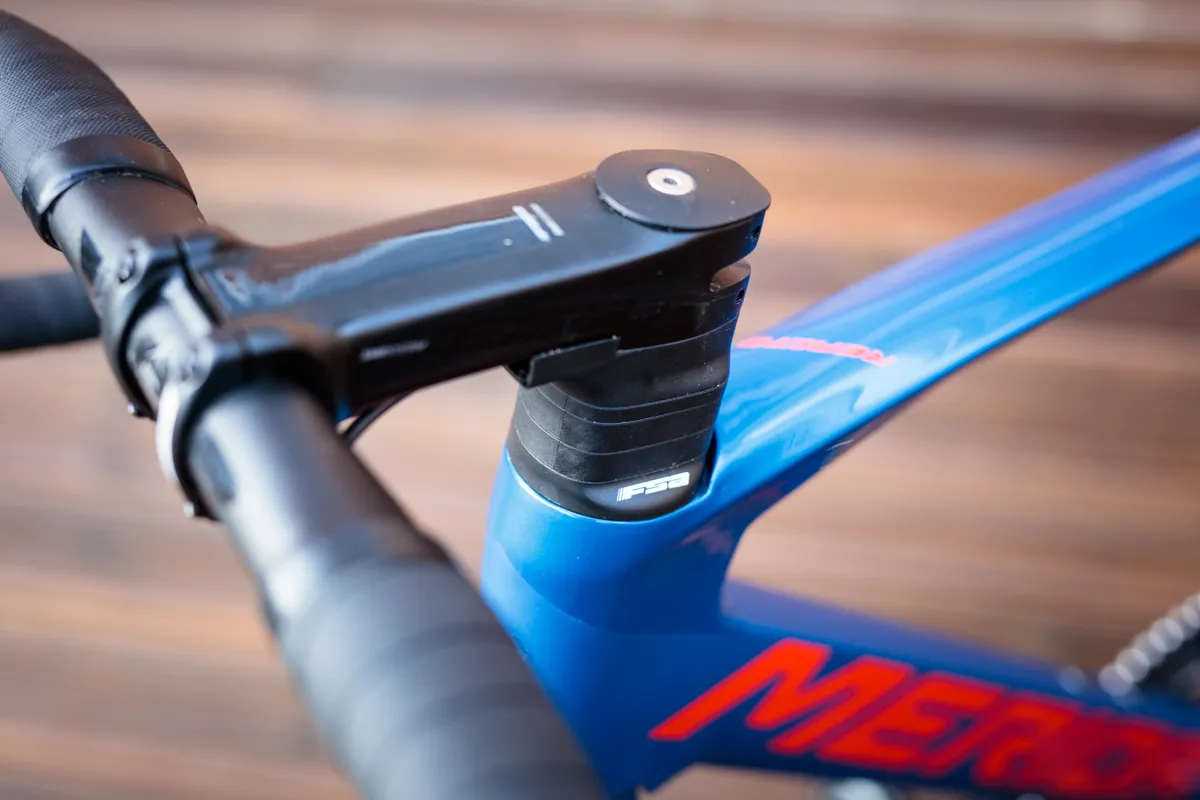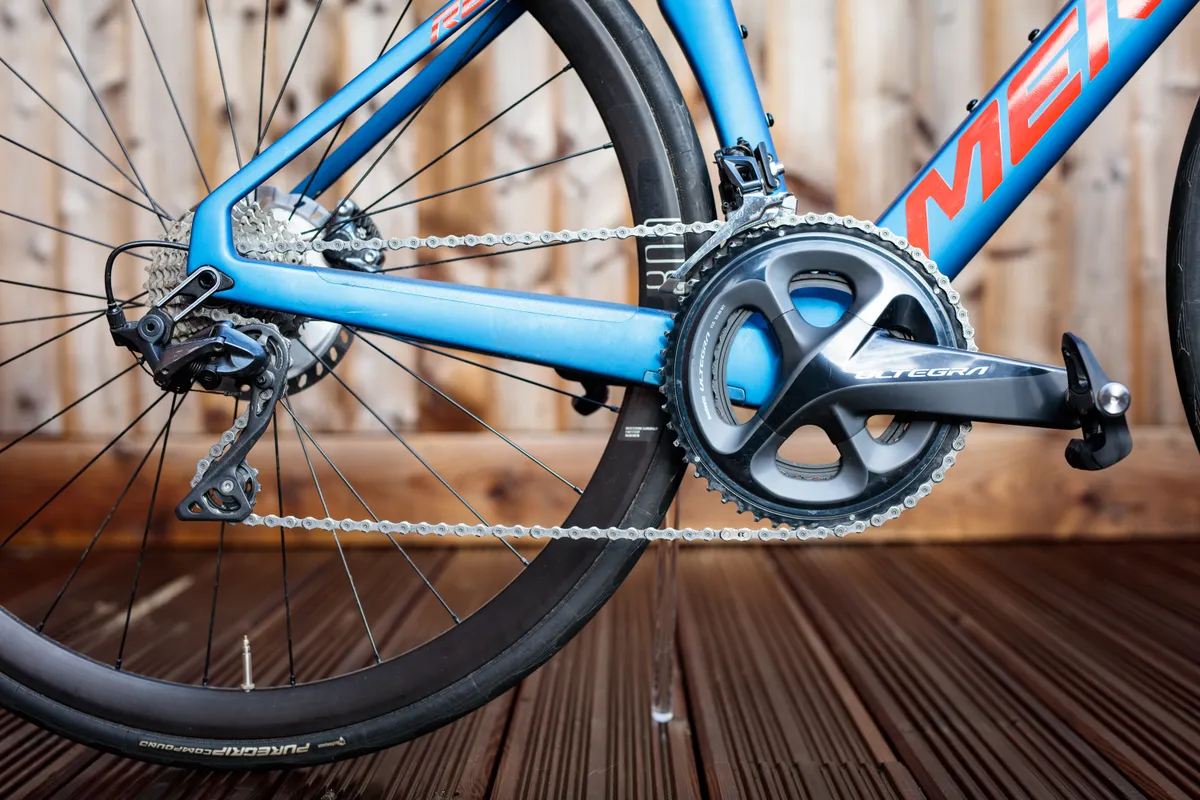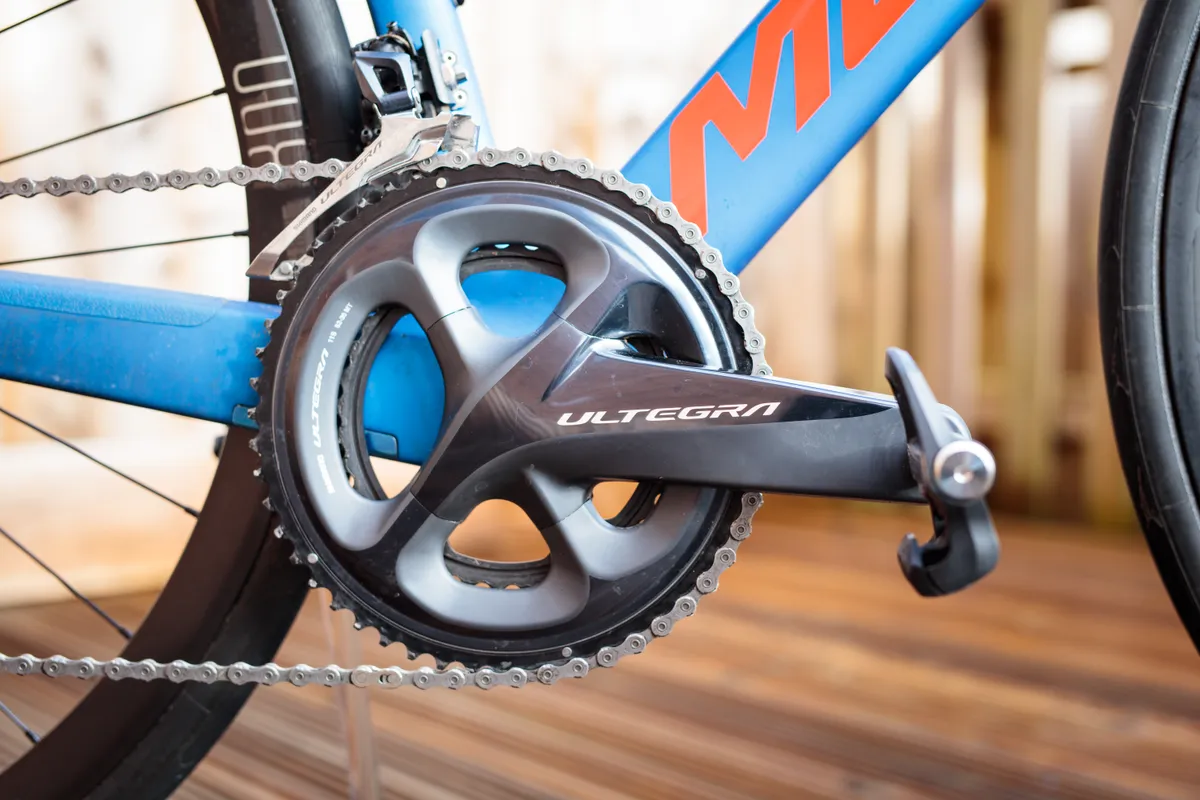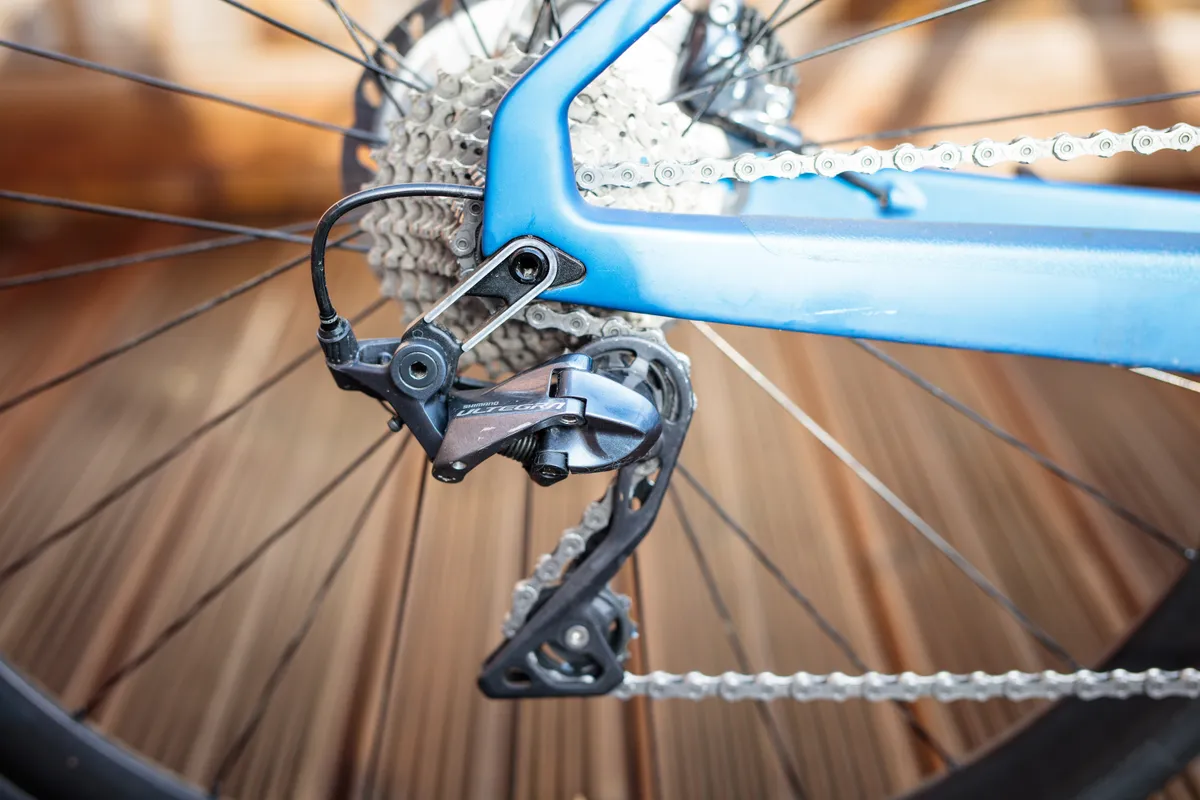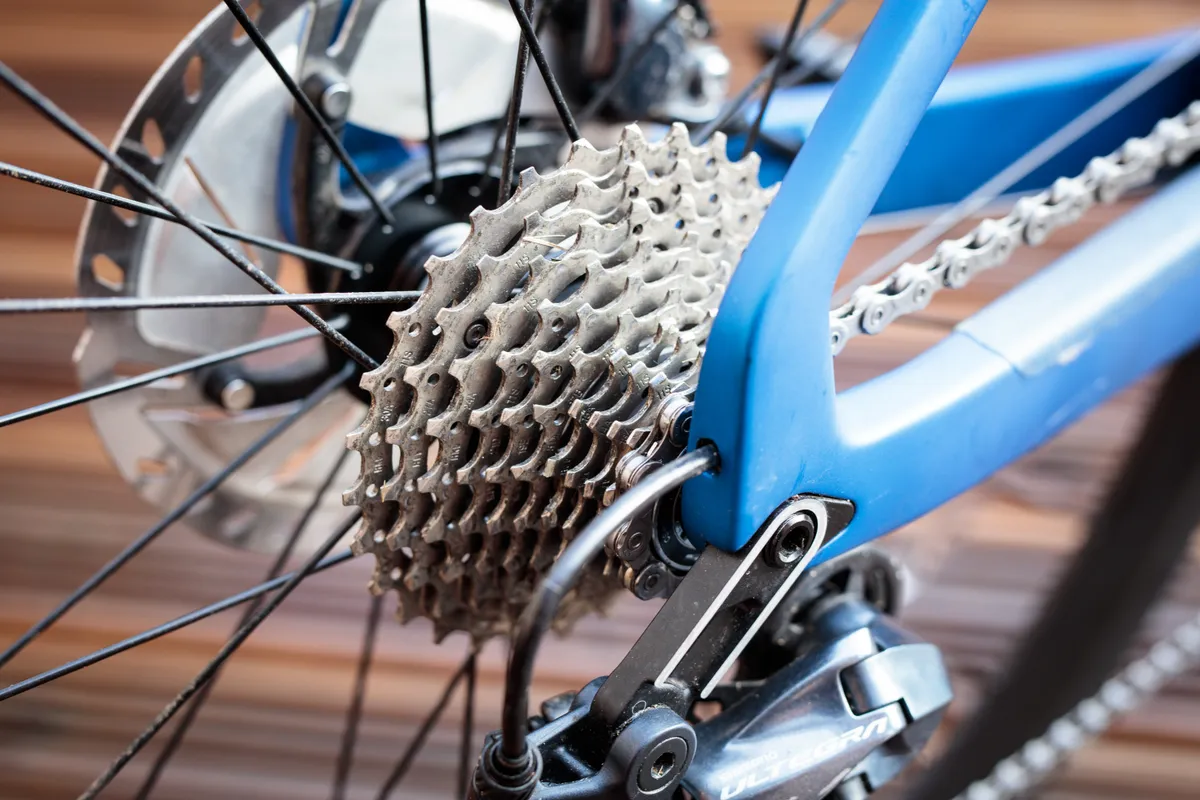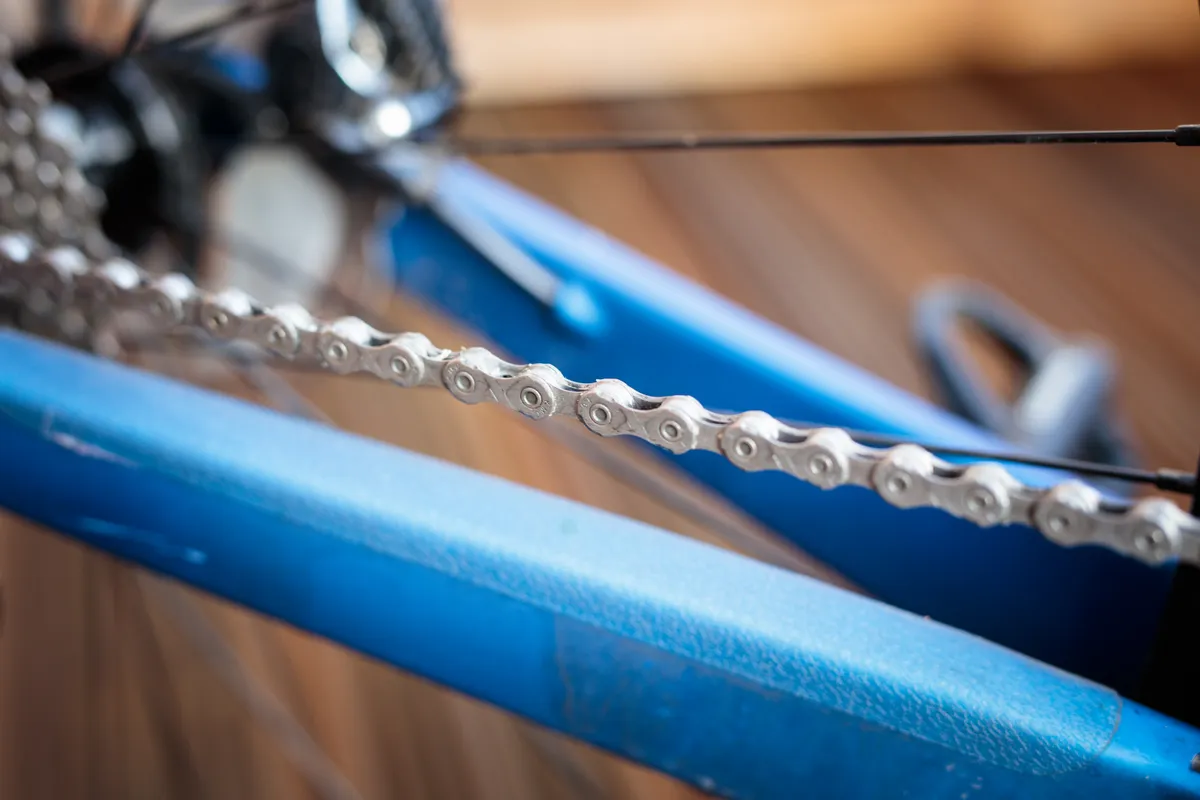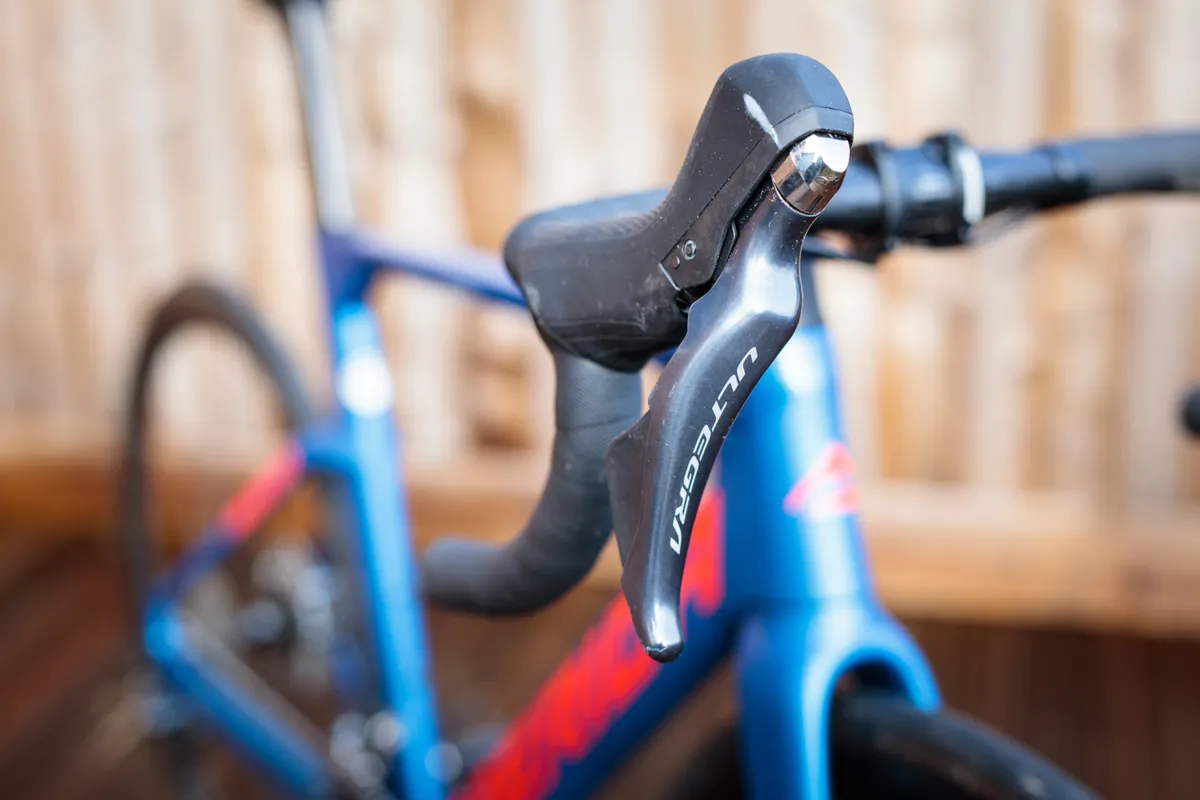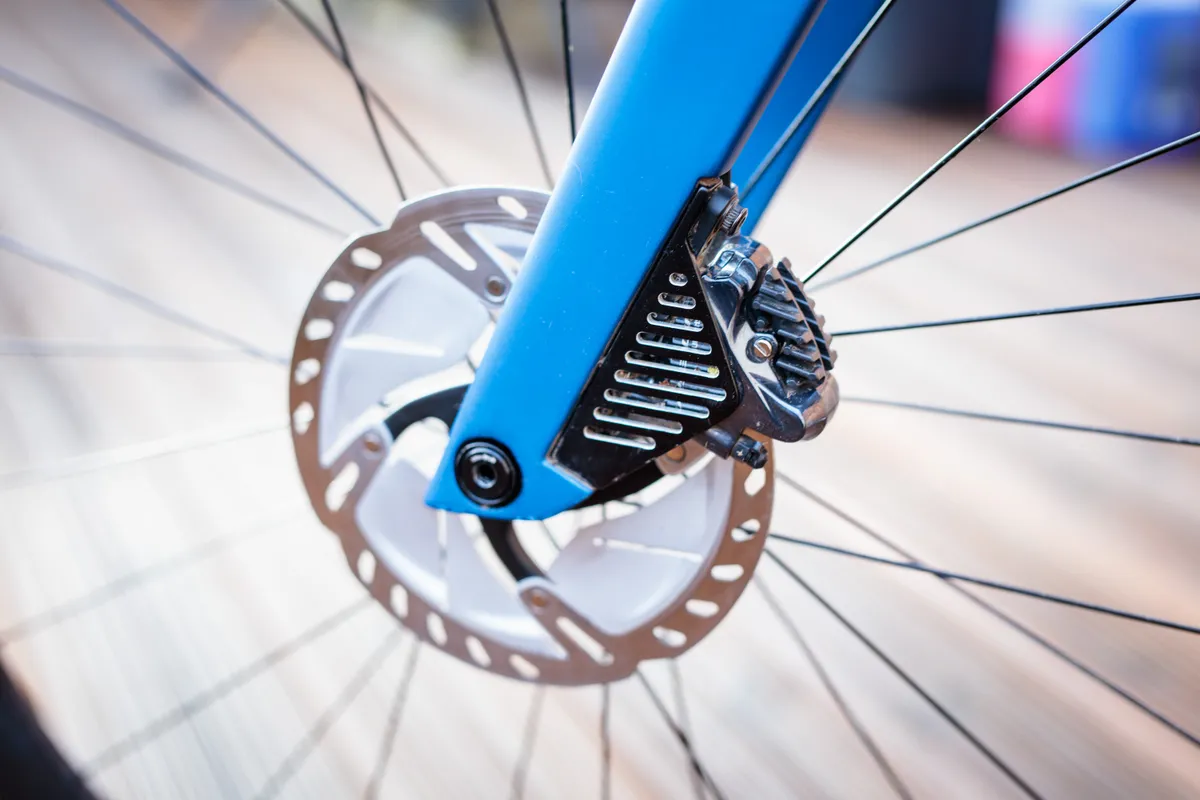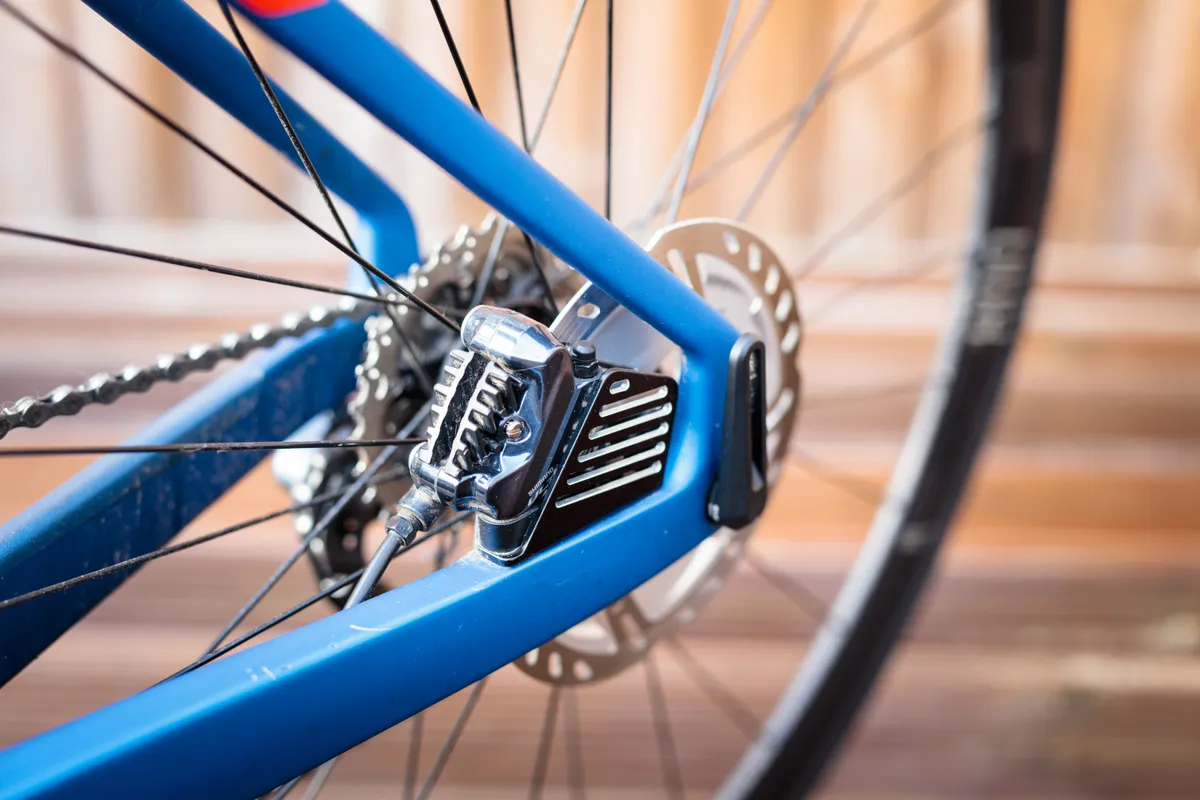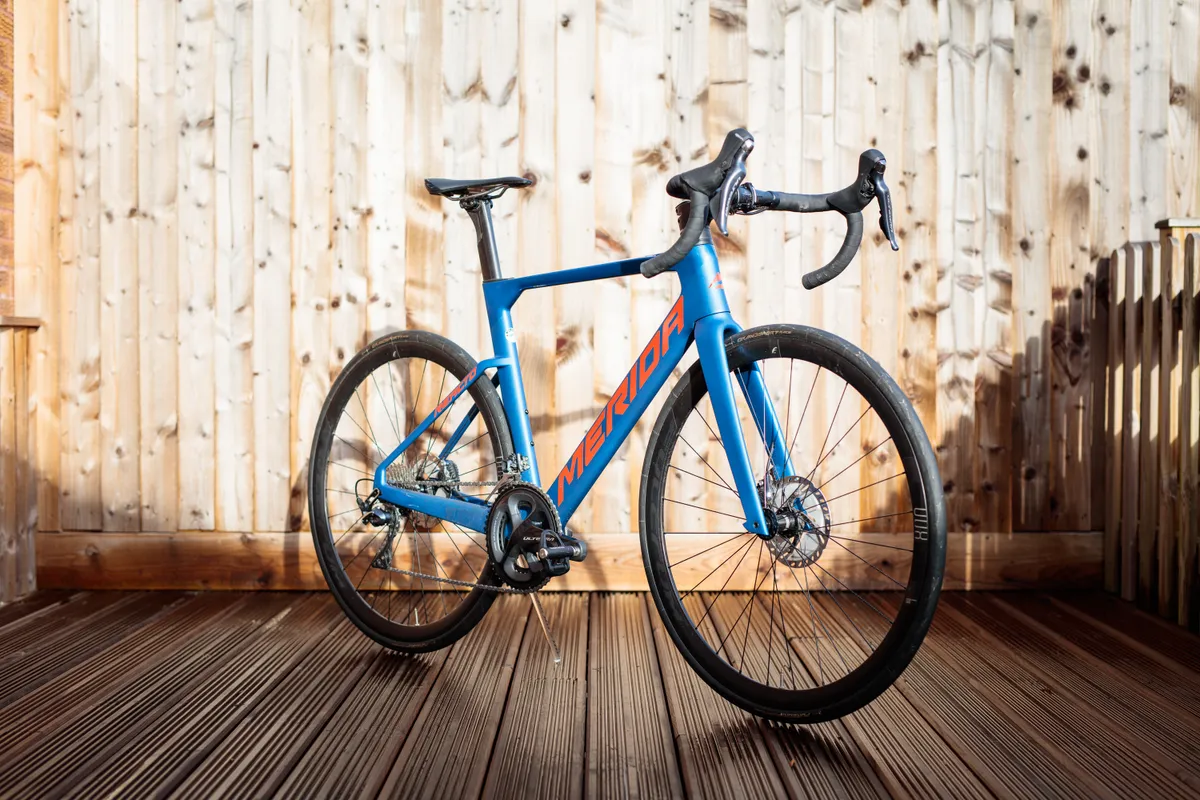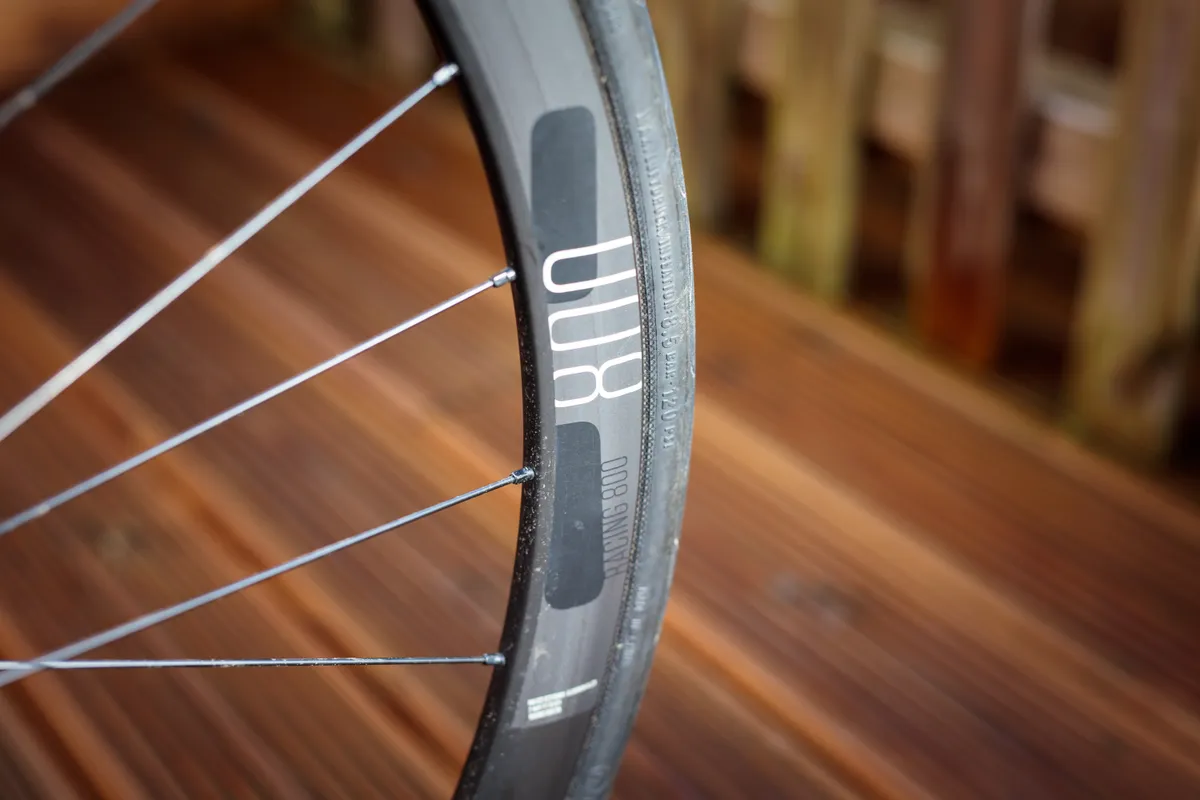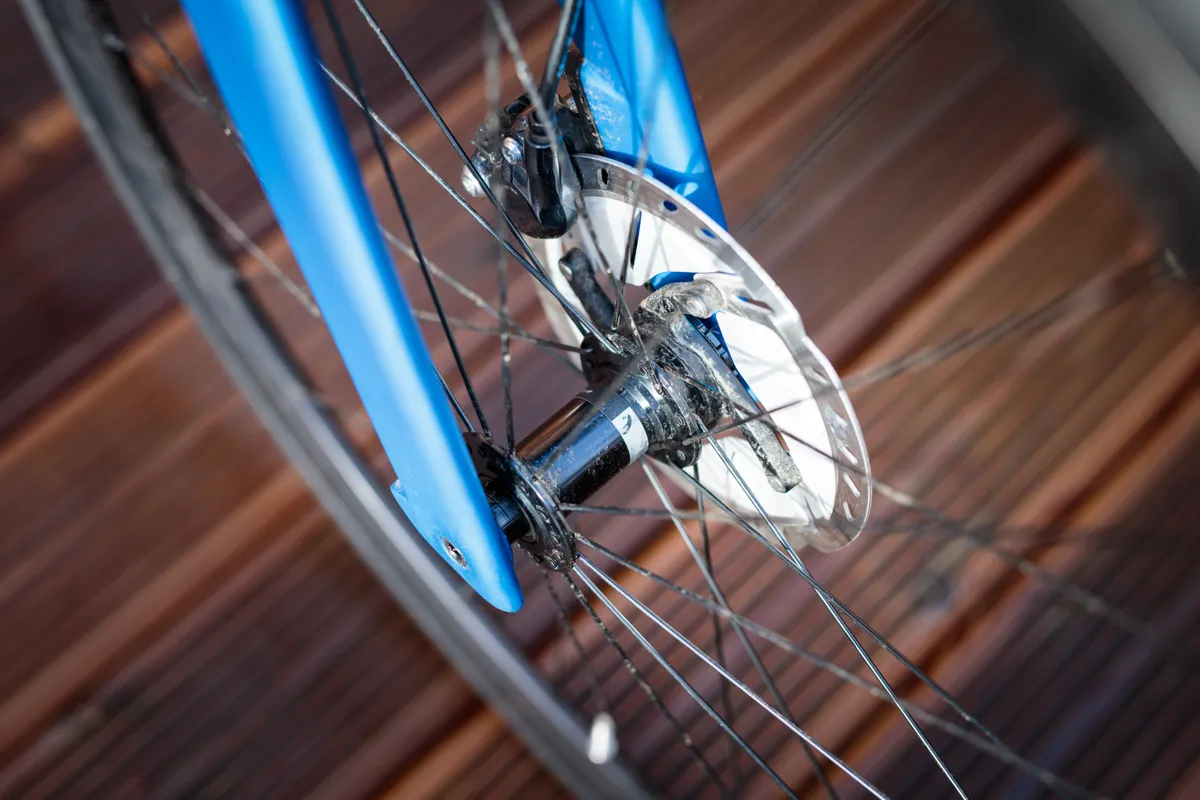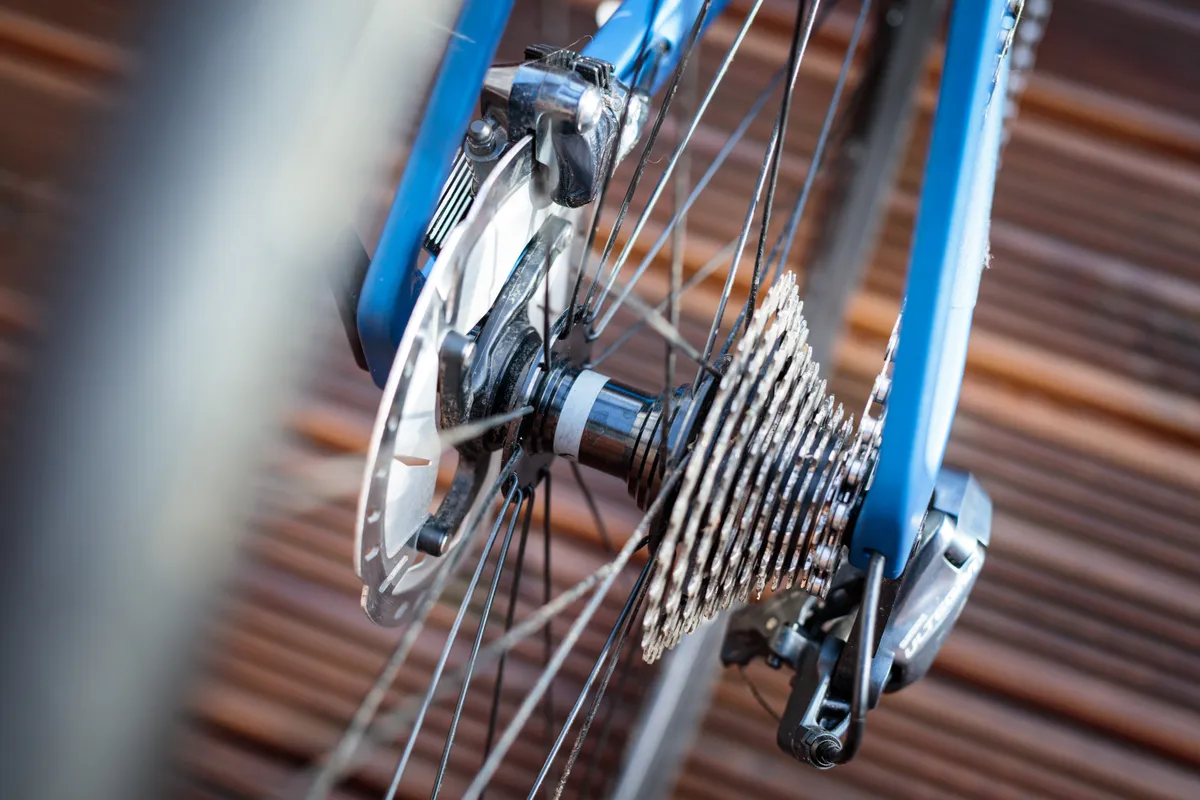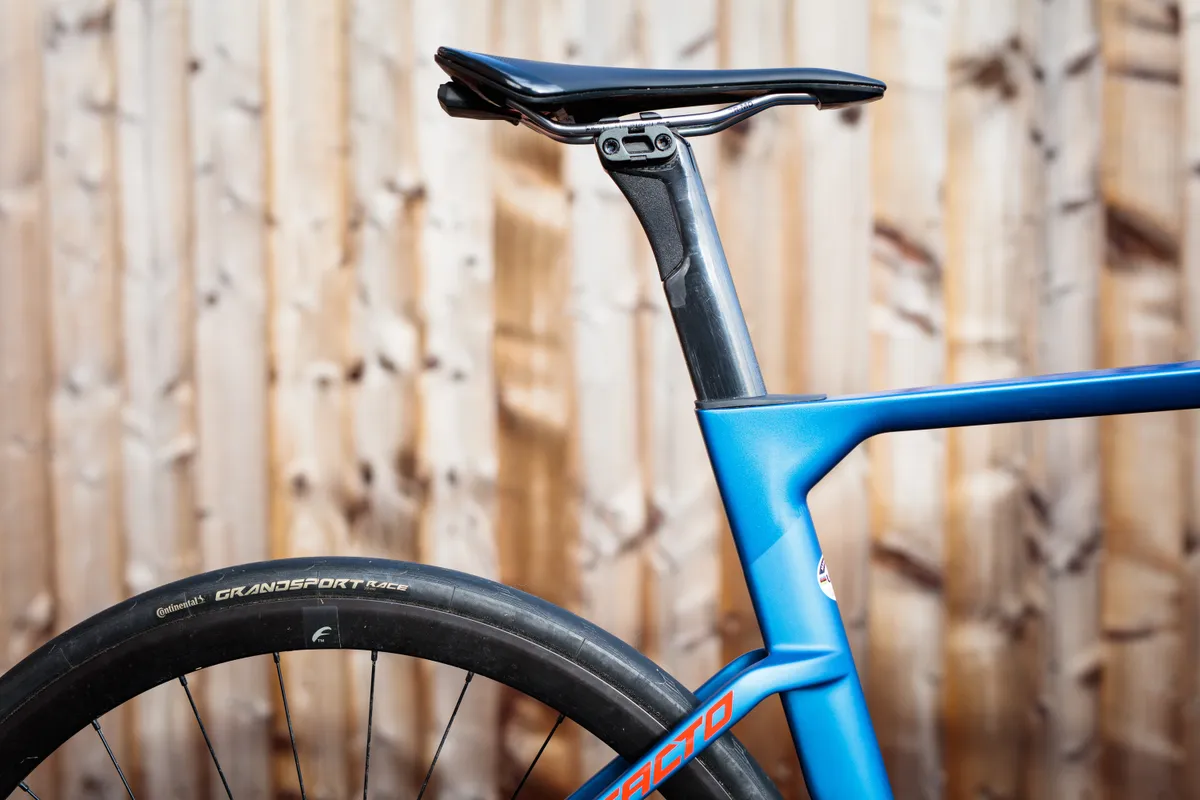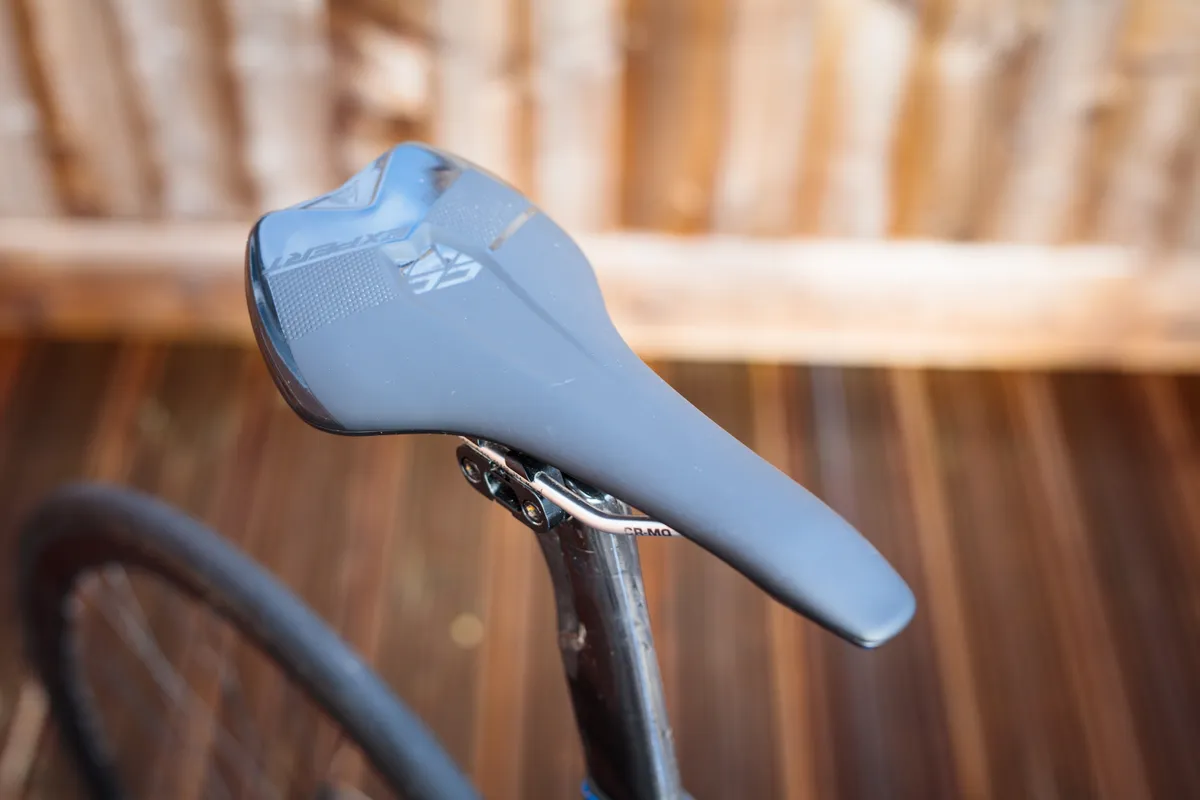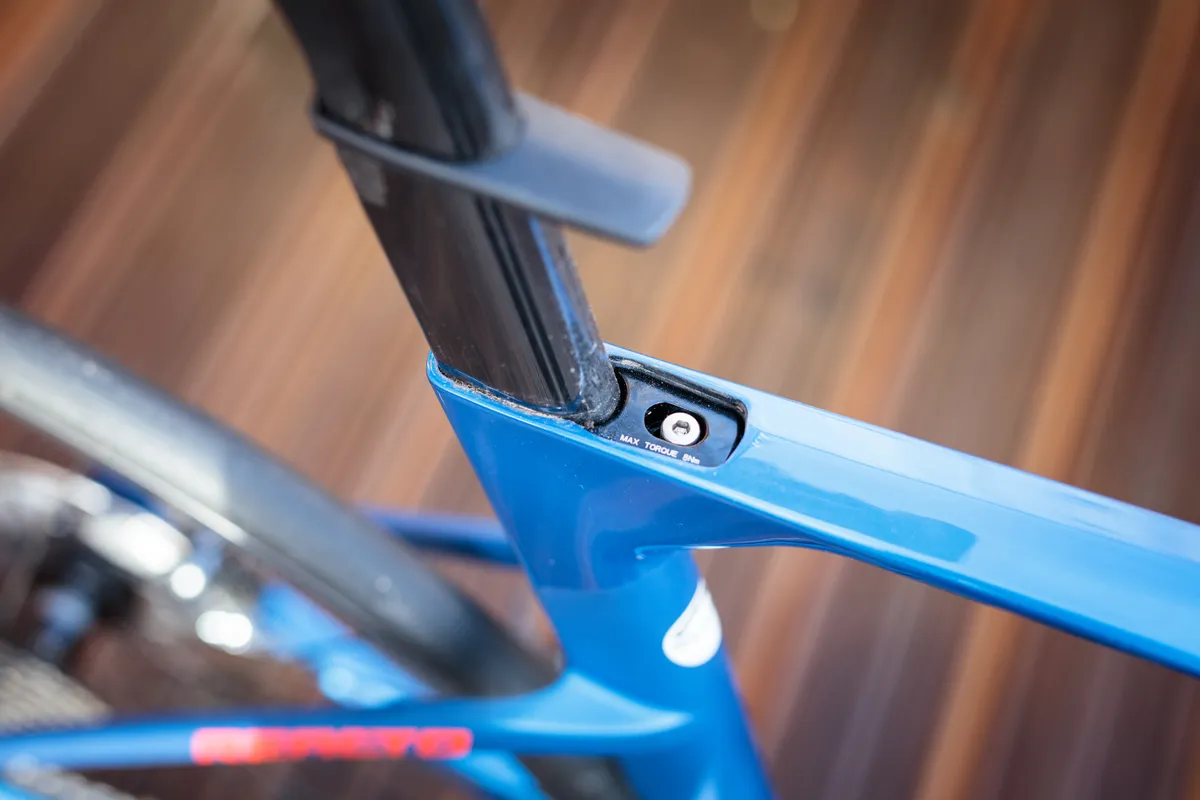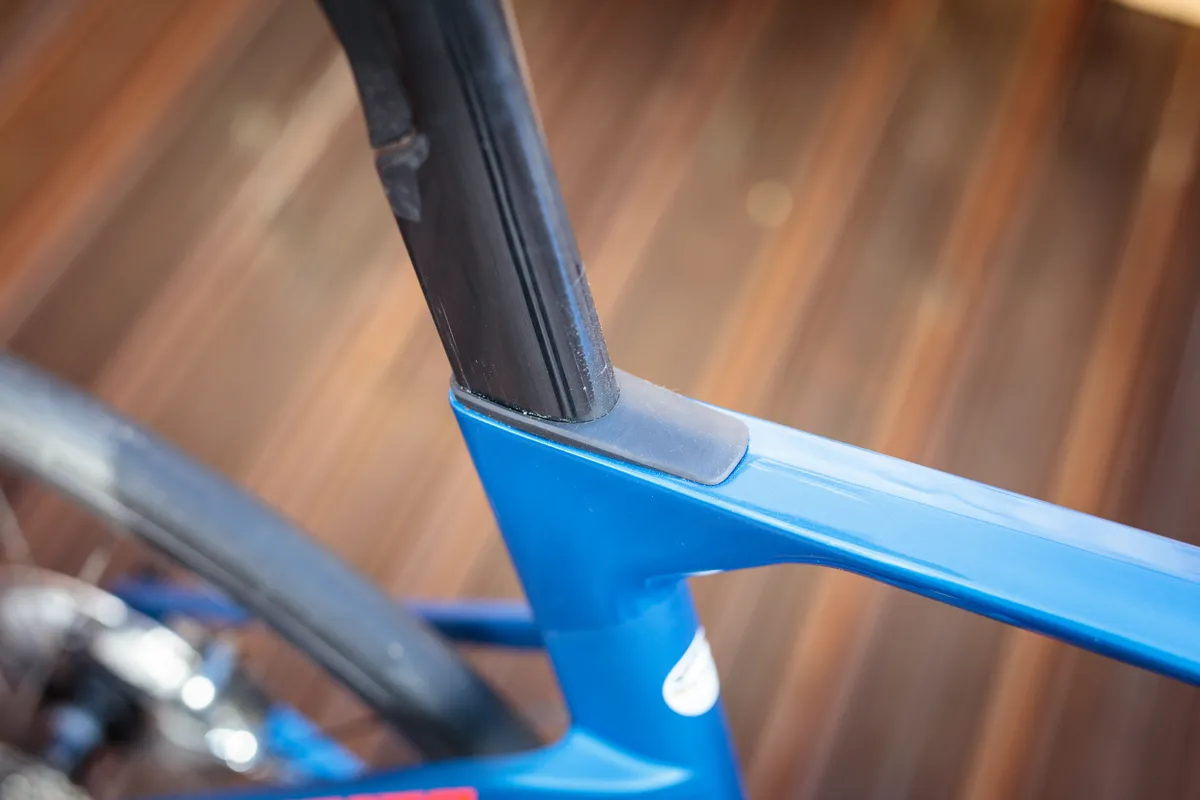The Merida Reacto 6000 is a great value aero road bike with a stiff, efficient frameset and excellent handling characteristics. It has smart cable routing, with good quality finishing kit and it’s also surprisingly comfortable.
Average wheels and tyres hold it back from a perfect score, but, if you’re looking for a fast road bike that can be upgraded down the line, this is a fantastic option.
Merida Reacto 6000 frameset
Now in its fourth generation, the new Reacto CF3 frameset is the star of the show, and differs from the top-spec Reacto CF5 frameset only in terms of weight.
The tube shapes (and therefore the aerodynamics), tyre clearance, as well as – according to Merida – the stiffness and compliance qualities, are otherwise the same as the more expensive CF5 versions.
According to Merida, that difference in mass is around 200g, with a size medium CF3 frame and fork claimed to weigh 1,165g and 490g (+/- 3 per cent) respectively. That’s nothing worth losing sleep over on a bike like this.
Of course, comparing frameset weight alone doesn’t show the full picture. The weight of the components and finishing kit also make a big difference, and the total weight of this bike, at 8.53kg without pedals or bottle cages, is admittedly not particularly impressive on paper.
Nevertheless, I’d argue (as I often do) that bike weight isn’t actually overly important to the performance of an aero race bike anyway. While it definitely affects how a bike feels, it doesn’t meaningfully impact how fast it is from A to B, unless you only race up long, steep climbs.
Part of the reason this bike weighs what it does, though, is because of compromises made to meet an impressively competitive price of £2,800.
Merida Reacto 6000 build
For the most part, the Reacto 6000’s build is very good.
The cockpit, for example, is a highlight for its practicality. It goes against the grain of modern aero bike design and uses a non-integrated, non-proprietary setup, with a standard, aluminium handlebar and stem.
Part of this is undoubtedly due to cost-saving measures (the higher-end Reacto models use a Vision Metron integrated handlebar), but the Merida Expert CW handlebar is a comfortable shape, plenty stiff when yanking on the drops in a sprint, and the profiled tops help close the aero performance gap on pricier setups.
Thanks to the use of FSA’s SMR (Smart Cable Routing) system, the gear and brake cables are, for the most part, tucked tidily away from wind.
The only real downsides of the SCR system are that it requires a proprietary headset and spacers, and the aero profiled stem isn’t a lightweight option either, at 220g for a size 120mm.
You don’t need to use the ‘correct’ FSA stem, though, if you don’t want to. Any standard 1⅛ inch stem will fit the fork steerer, it just won’t integrate with the headset spacers as cleanly.
This front end almost certainly gives up a few grams of drag compared to the fully integrated cockpits found on the 2021 Canyon Aeroad or Trek Madone SLR, which also look incredibly slick. But, giving up a small amount in aerodynamic drag for a large increase in user serviceability and customisation options is likely a worthwhile trade-off for the majority of amateur cyclists and home mechanics.
It means a change in stem length, or handlebar – often needed for an optimised bike fit or simply to improve your aerodynamic efficiency – is simple.
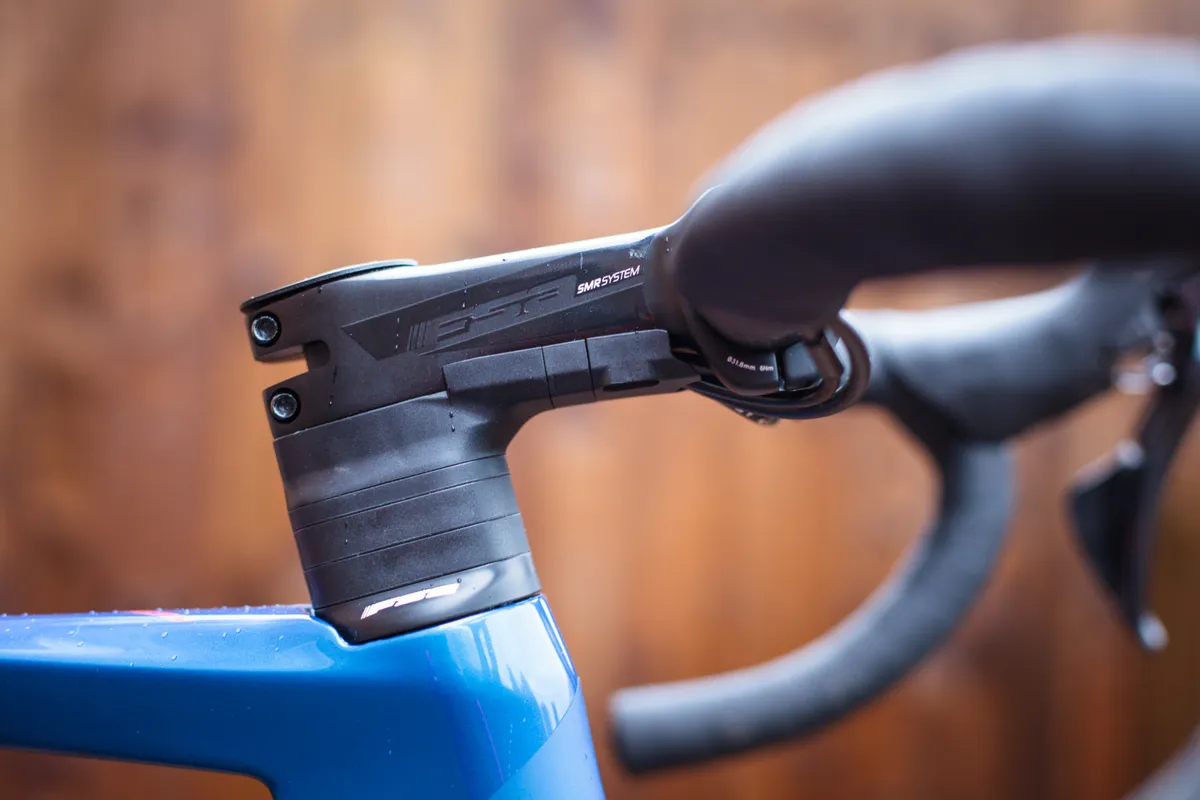
Drivetrain, wheels and tyres
Shimano’s Ultegra R8000 groupset, with hydraulic disc brakes, is as excellent as ever.
The only real downside to the groupset is that the disc brakes have a tendency to howl on wet, mucky days. This doesn’t affect the braking performance (they’ll still stop you just as fast), but it can be disconcerting for other riders when cycling in a group.
Merida has swapped in a Shimano 105 R7000 cassette and a KMC X11 chain, presumably for cost-saving reasons. This doesn’t affect the performance at all, but the cassette swap adds about 35g.
I also appreciate the addition of a GS (medium cage) rear derailleur. It’s not needed for the 11-30t cassette specced as stock (the chainrings are 52-36t), but it gives you the option to swap in a larger cassette later on, should you be planning a trip to sample some of Europe’s toughest climbs at any point.
Like the Merida Scultura Endurance we recently reviewed, the Reacto 6000 gets a set of Merida’s removable disc brake cooling fins. Their heatsink function is the same – they’re intended to act as thermal conductors and aid the cooling of the disc brake rotors, thus helping to prevent brake fade under sustained heavy use – but unlike the ones on the Scultura Endurance, these sit within the bounds of the frame tubes, so there’s practically no chance you’d scuff a shoe on them.
Given the Reacto 6000 has 160mm Shimano Ultegra RT800 disc brake rotors front and rear, the heatsinks are overkill for those who don’t live in mountainous regions, but they don’t detract from the bike’s performance in any way. I also think they look quite cool, so I’d happily leave them in place.
The low point in the build is the Fulcrum Racing 800 DB wheelset.
The semi-aero alloy rims, with their 34mm depth, 24.5mm external width and 19mm internal width are fine, but the spokes aren’t aero profiled and the hubs are fairly basic.
They’re also heavy, with the entire wheelsystem (wheels, tyres, inner tubes, cassette and brake rotors) contributing 3.26kg to the total weight of the bike.
On a more positive note (unless you like the hum of a freehub), the wheelset is virtually silent and the rims can be set up tubeless with the addition of tubeless tape and valves, but you’ll need to purchase these separately.
It’s not that there’s anything particularly wrong with this wheelset, it just doesn’t sparkle or get the best out of the frameset in the way a better, more aerodynamic set would likely do.
The Continental Grand Sport Race clincher tyres feel better than expected on the road, with decent comfort and grip levels, but even Continental admits their rolling resistance doesn’t match its premium GP5000 tyres. They’re not tubeless-ready either, so if you want to ditch the inner tubes you’ll need new tubeless road tyres as well.
Tyres are a crucial part of the performance equation for a race bike, so it’s a slight shame to see Merida making compromises here. As we’ve discussed before, it’s not something we’re ever going to be thrilled about.
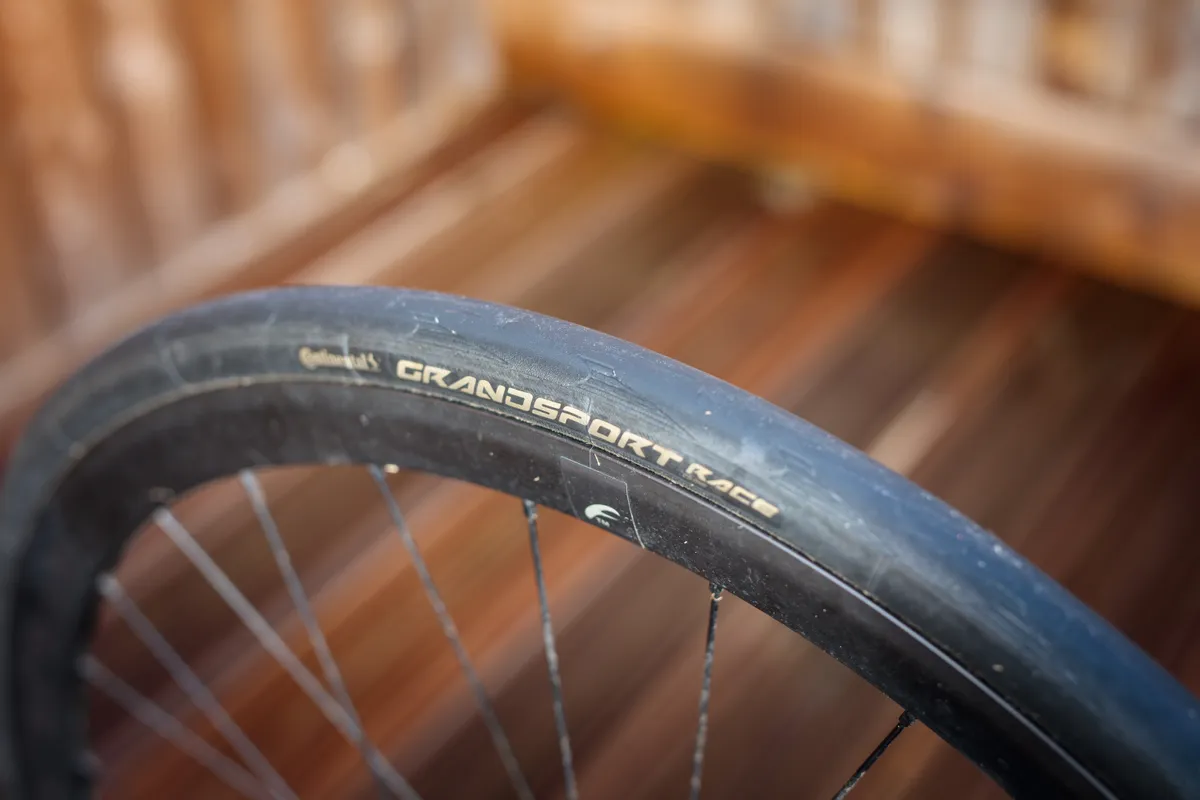
At this price point, a build with a Shimano 105 R7000 drivetrain (as specced on the cheaper Reacto 4000) alongside better wheels and tyres might have made for an even better performing bike overall.
I appreciate the excellent Ultegra groupset is a draw for many, though, and it’s possible that speccing the Reacto like that could increase the RRP as well.
Geometry, handling and ride quality
The Reacto is a unisex bike, so there aren’t any women’s-specific builds, and there are six sizes in the range, from XXS (47cm) to XL (59cm).
The geometry is carried across from the upper tier CF5 framesets. As my colleague Warren Rossiter commented when he tested the top-spec Merida Reacto Team-E, the long and low position, combined with the relatively steep seat tube and head tube angles is ideal for racers but won’t be for everyone. This isn’t a bike designed for people with back problems.
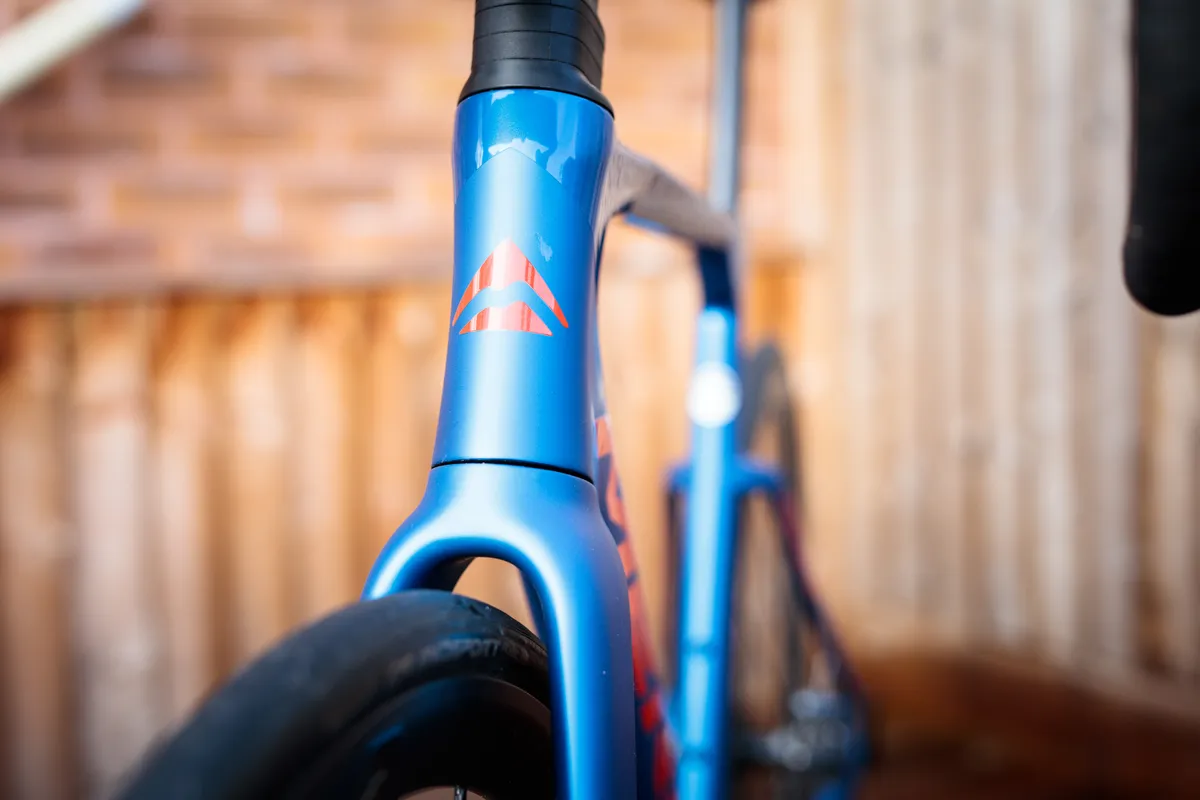
As someone who’s used to riding fast bikes with steep seat-tube angles, I felt right at home on the Reacto. And, given your body is the greatest overall contributor to aerodynamic drag, it makes sense for a bike like this to cajole you into a more aggressive riding position.
That doesn’t mean the Reacto 6000 is uncomfortable, though, just that it pitches your body weight forward a little more, compared to a bike with an endurance geometry. This could be more tiring on your hands, arms and shoulders over the course of long rides on rough roads, but I didn’t find it an issue during testing.
The Merida Expert CC saddle is passable. It’s fairly comfortable over short distances, but at 279mm in length and 138mm wide, it’s a little long and narrow for my tastes. It also lacks a central pressure relief channel that would help make it more comfortable when hammering away in the drops.
A shorter, more progressively shaped saddle (as is the trend for performance oriented road bikes), like the Prologo Scratch M5 found on the pricier CF5 builds, would seem a better fit for a bike with such racy geometry.
The heavily dropped seatstays and clever seatpost, with its cut-out section near the top, nevertheless do a good job of cushioning things at the rear.
Likewise, the 25mm Continental tyres measure around 27.5mm when inflated to about 70psi and have flexible 180TPI casings that give a plusher ride than expected.
If you need more comfort, the Reacto 6000 officially has clearance for tyres up to 30mm, which should be enough to tackle anything that can be reasonably described as ‘a road’. This was ‘gravel bike’ territory only a few years ago, which just goes to show how things have changed (for the better).
The Reacto 6000 also handles exceptionally well. Technical descents and fast corners feel practically intuitive, and it was always stable and confident at high speeds.
Part of this can likely be attributed to the Reacto’s 990mm wheelbase and 408mm chainstays (size medium), which are 10mm and 3mm longer, respectively, than on a size medium Giant TCR Advanced Pro Disc, for example.
This makes it slightly more stable and less responsive to sharp changes of pace, but that was something I appreciated rather than lamented.
Of course, geometry and handling are personal to a degree, depending on what kind of riding you do, but this is one of the best handling bikes I’ve ridden recently.

Merida Reacto 6000 versus the competition
If you’re lusting for a proper aero bike at this price point, there actually isn’t much competition.
Orro’s Venturi aero bike can be had with a similar Ultegra spec for £2,699.99, and Wilier recently announced the Cento10 SL with Shimano 105, which costs £2,745, but that’s about it for aero road bikes under £3,000.
Giant’s Propel Advanced 1 Disc comes with deep-section carbon wheels. But, at £3,299, it also costs just under £500 more, has a carbon fork with an aluminium steerer tube, and (according to Giant) only has clearance for up to 26mm tyres.
It even undercuts direct-sales brands like Canyon. Its cheapest aero bike, the Aeroad CF SL 7 – which has a Shimano 105 drivetrain, an integrated carbon cockpit and Reynolds deep-section carbon wheels – costs £3,399.
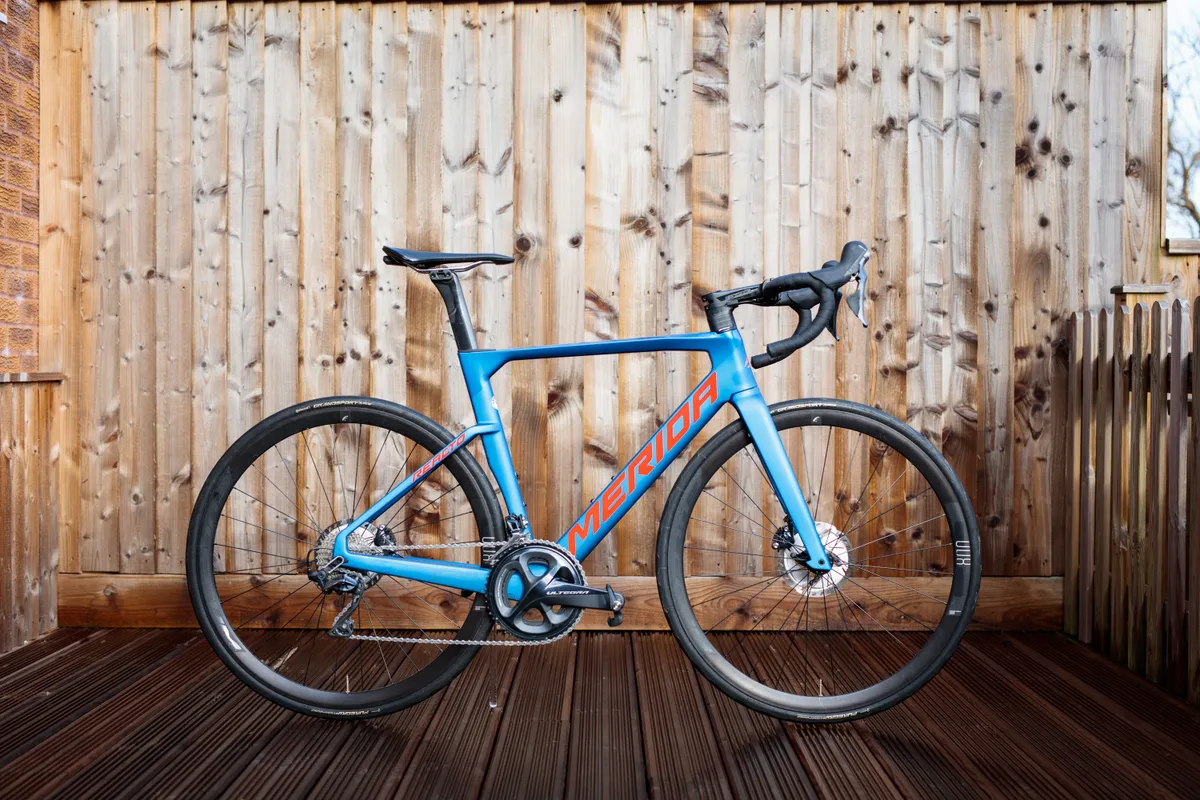
Merida Reacto 6000 overall
The Merida Reacto 6000 is a fast aero road bike with impressively confident handling characteristics. It’s great value, too.
Although it’s heavier than some bikes at this price point, the aero gains are what count here and, pleasingly, those come without too many compromises in liveability or user-serviceability.
The spec isn’t perfect, but it’s clearly been designed to hit what is a very competitive price point, and the frameset is eminently upgradeable.
It’s perhaps worth considering the cheaper £2,250 Reacto 4000 with Shimano 105, and using the money saved to buy better wheels and tyres. But, if you really want the Ultegra groupset you won’t be disappointed.
Product
| Brand | Merida |
| Price | €3099.00, £2800.00 |
| Weight | 8.53kg |
Features
| Fork | Merida Reacto CF3 IV Disc |
| Stem | FSA SMR ACR, 110mm |
| Chain | KMC X11 |
| Frame | Merida Reacto CF3 IV Disc |
| Tyres | Continental Grand Sport Race clincher, 700x25c |
| Brakes | Shimano Ultegra R8000 |
| Cranks | Shimano Ultegra, 52/36t |
| Saddle | Merida Expert CC |
| Wheels | Fulcrum Racing 800 DB |
| Headset | FSA ACR |
| Shifter | Shimano Ultegra R8020 |
| Cassette | Shimano 105 R7000, 11-30t |
| Seatpost | Merida Team CW |
| Grips/tape | Merida road expert handlebar tape |
| Handlebar | Merida Expert CW |
| Bottom bracket | Shimano press-fit (SM-BB72-41B) |
| Available sizes | XXS, XS, S, M, L, XL |
| Rear derailleur | Shimano Ultegra R8000 GS |
| Front derailleur | Shimano Ultegra R8000 |
